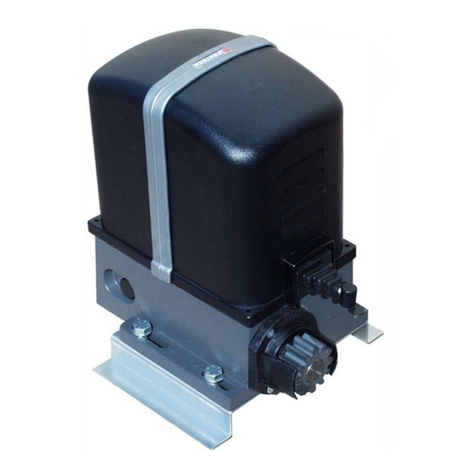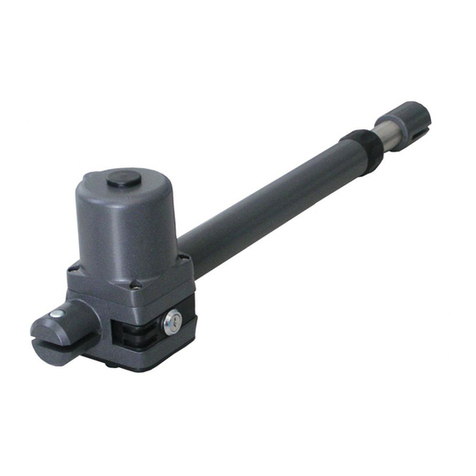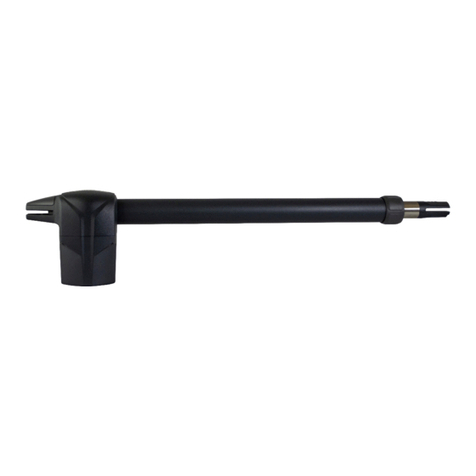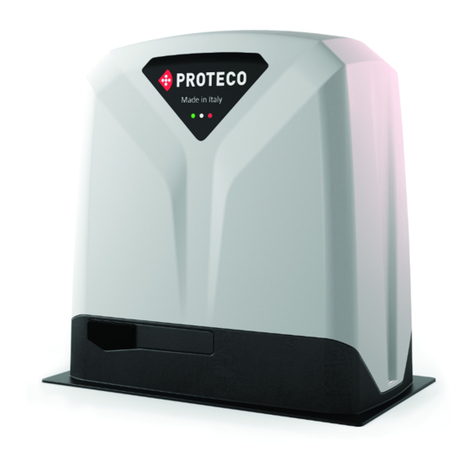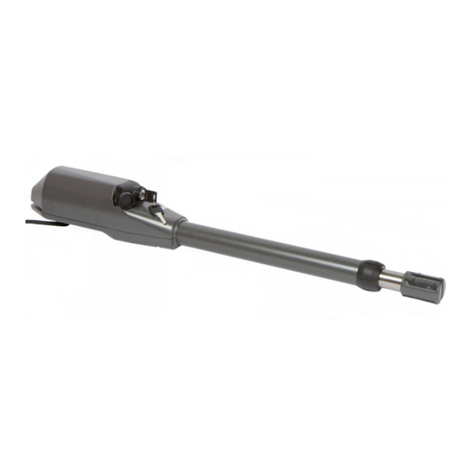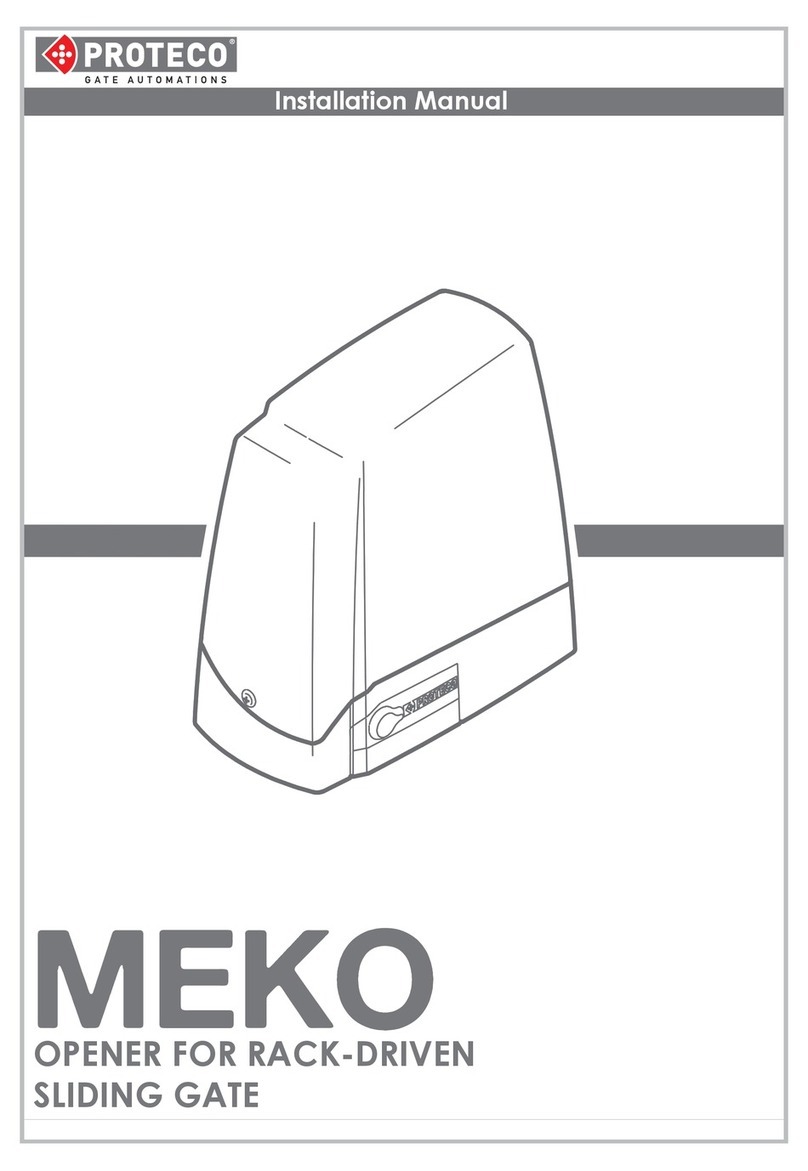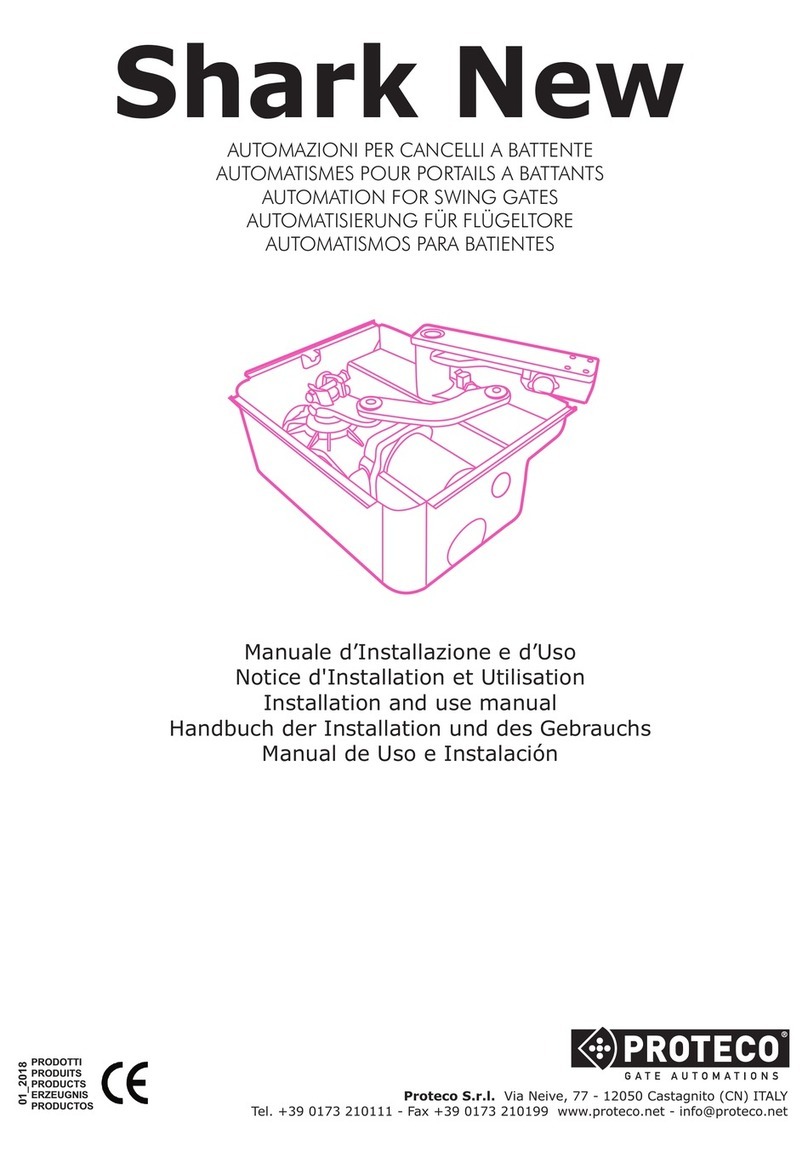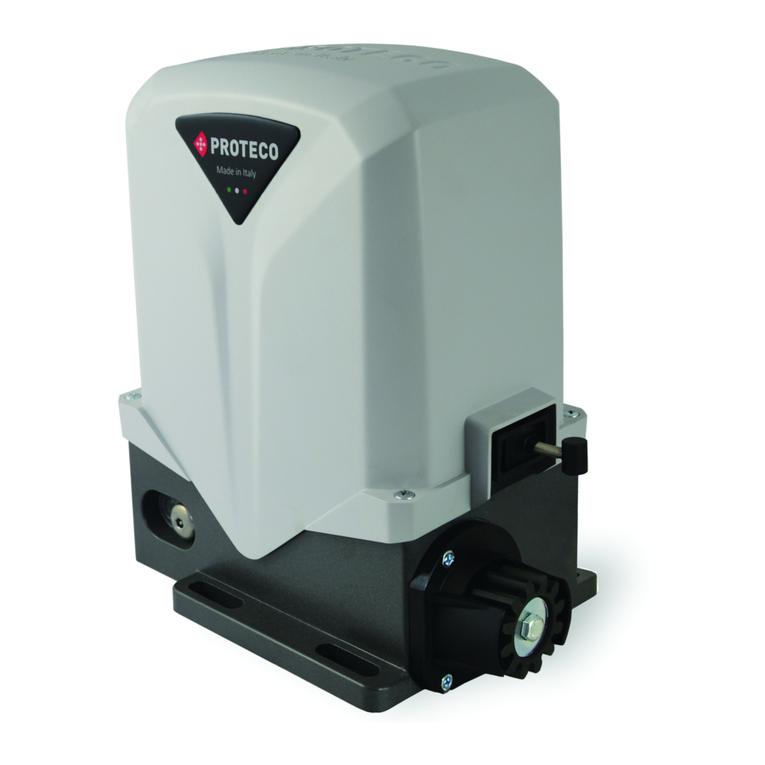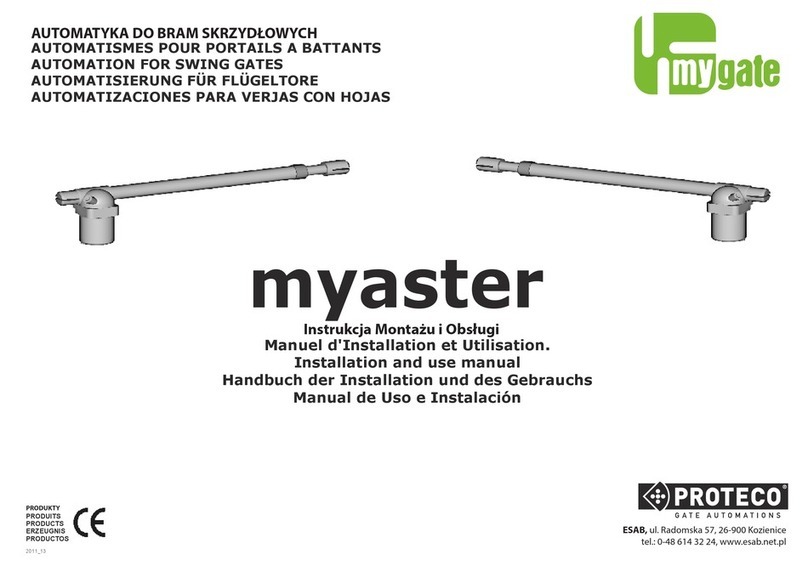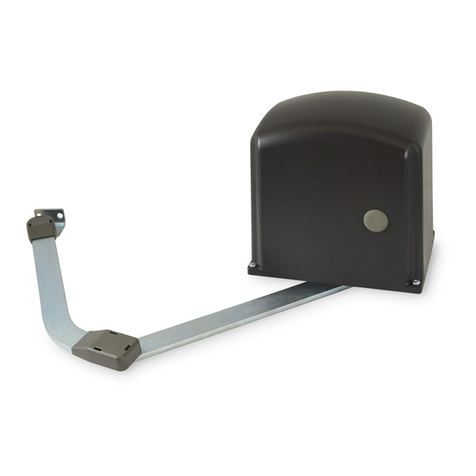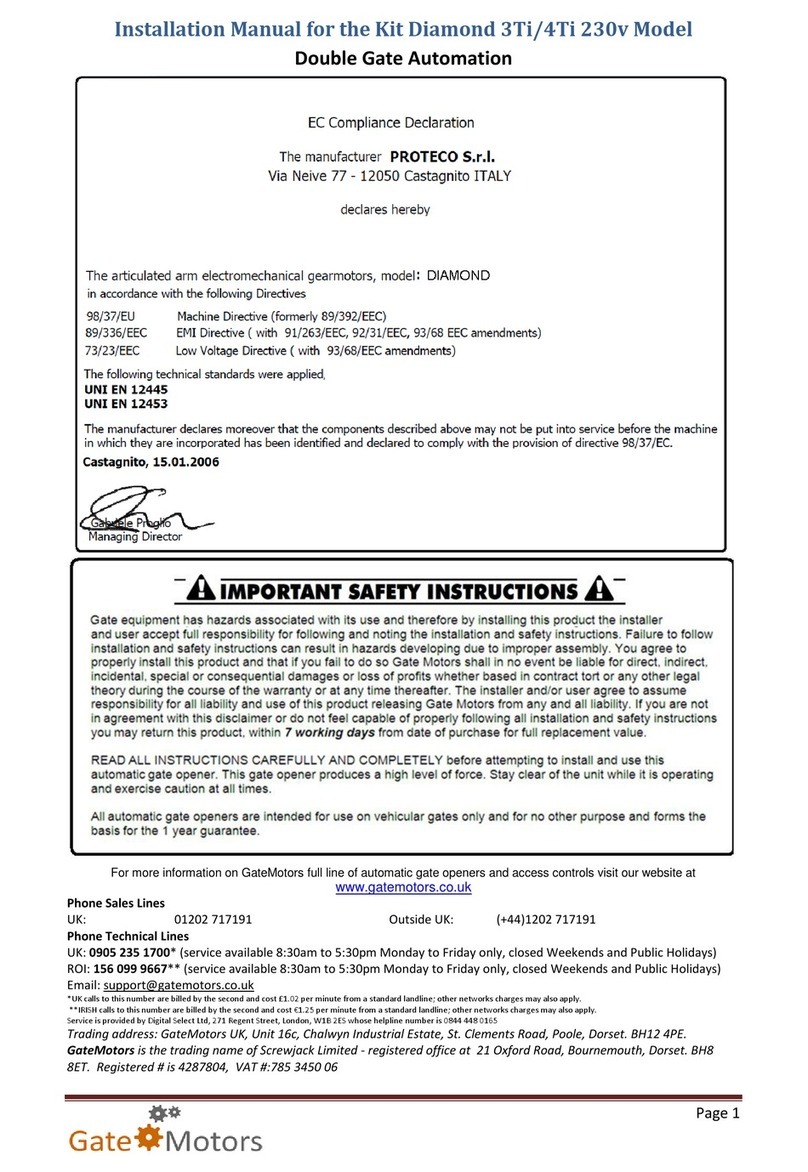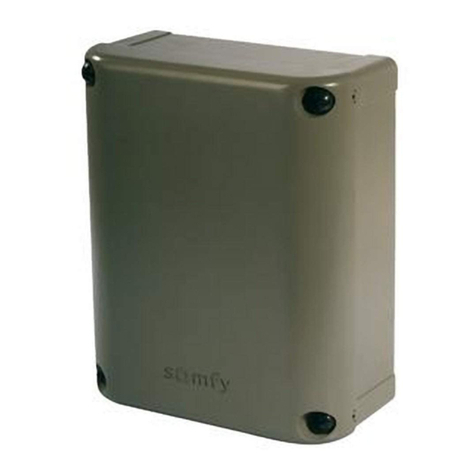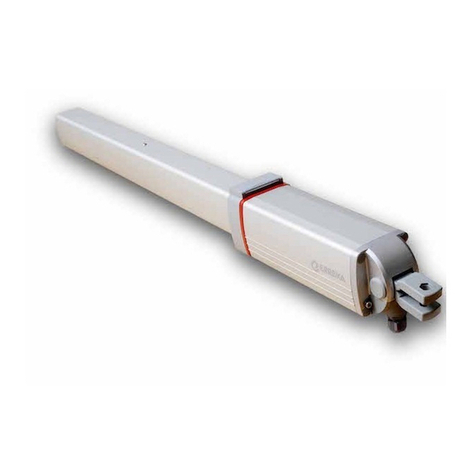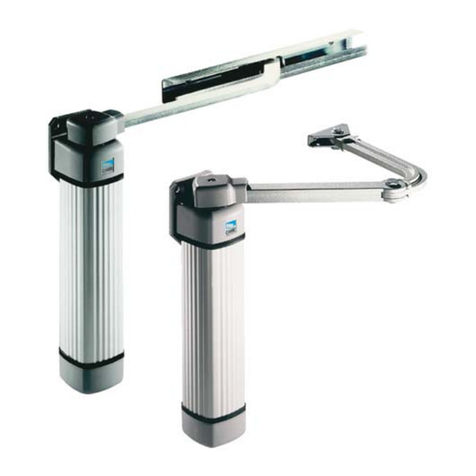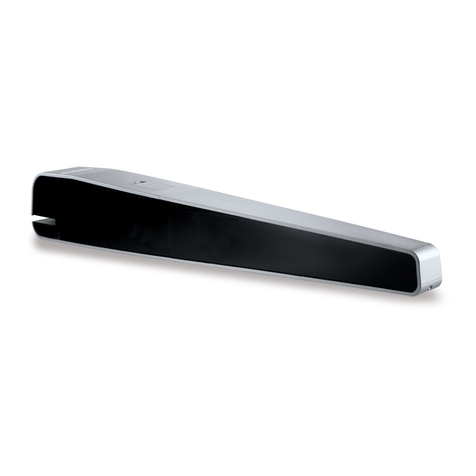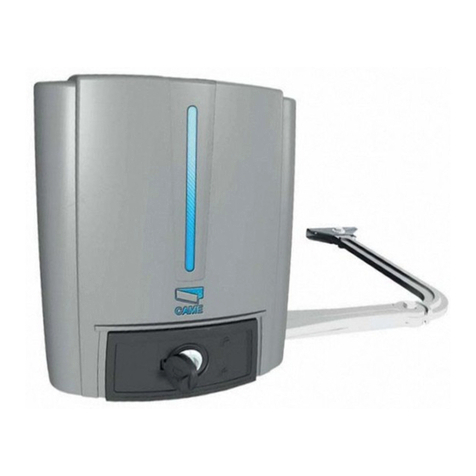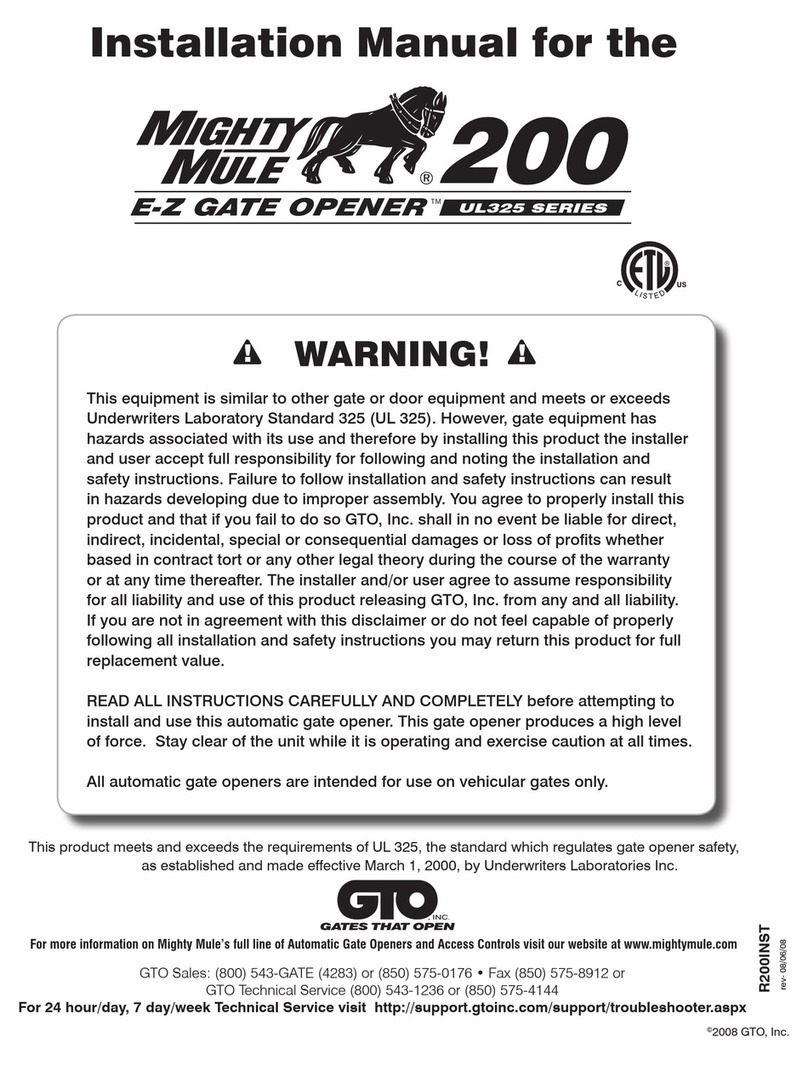CRITÈRE DE SÉCURITÉ
Avant de commencer une quelconque opération d'installation il est absolument
indispensable de lire entièrement ce manuel.
2Vérifier que le kit est bien adapté en fonction des caractéristiques du portail.
3Vérifier que :
• Les charnières du portail soient en bon état.
• Qu'il y ait des butées latérales (obligatoires).
CONSIGNE POUR L'INSTALLATION
Raccordements :
• Utilisez le “Schéma de fonctionnement” et le schéma delà centrale électronique.
• Le câble électrique en sortie du moteur ne doit pas être tendu, mais faire une courbe
vers le bas pour empêcher que l'eau suinte a l'intérieur du moteur. (Fig. O)
• Tous les branchements doivent être effectués en absence d'alimentation électrique.
Prévoir un dispositif de sécurité, tel un différentiel ou disjoncteur (6Amp) sur la ligne
de l'appareil .
• Les lignes d'alimentations que ce soit aux moteurs, à la centrale ainsi que les lignes
d'alimentation des accessoires doivent être séparés pour éviter toutes interférences
qui pourraient causer des fonctionnements aléatoires de l'installation.
Pièces de rechange:
• Utiliser seulement pièces de rechanges d'origines.
• Ne détruisez pas les batteries comme des déchets qui sont habituellement enlevés
par le ramassage municipale, mais traitez-les comme des déchets industriels.
( lois n. 475/88)
Modalité d'installation :
• Pour une utilisation appropriée du produit et pour exclure toute possibilité de
dommages aux personnes, animaux ou véhicules, faire référence à la feuille
"Généralités" en annexe qui fait partie intégrante de ce manuel.
• L'emploi de ce dispositif doit respecter les normes de sécurité en vigueur dans le pays
d'installation ainsi que les normes de bonne installation.
Garantie :
• La garantie fournie par le constructeur est annulée en cas d'altération, de manque
d'entretien, d'utilisation impropre, de foudre, de surtension ou d'utilisation de la part de
personnel non qualifié professionnellement.
• Tout droit à la garantie s'annulera également en cas de:
Non respect des instructions reportées sur les manuels fournis avec les produits.
L'application même d'une seule pièce suivant une modalité non conforme à la
législation en vigueur ou l'utilisation de pièces de rechange non conformes et/ou non
expressément approuvées par le fabricant.
• Le constructeur ne pourra être tenu responsable des dommages éventuels
occasionnés suite à une utilisation impropre et inappropriée.
SEQUENCE D'INSTALLATION
1Avant de commencer quelconque opération d'installation est absolument
indispensable de lire tout cet manuel.
2Le “Critère de sécurité”
3Identifier le moteur droit et gauche.
4Vérifier la composition.
5Déterminer la position pour la fixation des les pattes.
6Vérifier la côte “D”
7Adapter le patte S1 ou S2 en correspondance du Tableau 1.
8Positionner les moteurs sur les pattes S1 or S2.
9Déverrouillage du moteur.
10 Fixer le patte S3 / S4 sur le portail.
11 Fixer la patte S3 à l'embout de fixation du moteur TI ou la patte S4 à la découpe du
moteur TA.
12 Positionner le fil comme da “Schéma de fonctionnement ”
13 Brancher la centrale à toutes les accessoires.
14 Programmez les télécommandes.
15 Programmez le “Temps de fonctionnement”.
16 Au cas de dysfonctionnement regarder la rubrique “Anomalies et Conseils”.
Au cas ou ce tableau ne répondrait pas a vos questions et ne résoudrait pas votre
disfonctionnement appeler notre service technique.
ACTIONNEUR BLOQUE
Les moteurs peuvent être fournis en version autobloquants.
L'électro-serrure doit être installée sur le vantail qui s' ouvre en premier et doit être reliée à
la barrette de raccordement de la centrale.
Position de la serrure électrique. (Fig. C)
Position 1: Serrure dans la battue.
(dans ce cas il est nécessaire utiliser le verrou model RT15 sur le deuxième vantail).
Position 2: Serrure au sol.
(dans ce cas n'est pas indispensable utiliser le verrou).
Il faut se rappeler de neutraliser la serrure d'origine ou au moins en la bloquant en position
ouverte et éliminer tous les verrous de fermeture.
ACTIONNEUR DROITE OU GAUCHE (Fig. D)
Les moteurs sont fournis en version droite ou gauche.
On établit que le vérin est Droit ou Gauche en regardant le portail du côté intérieur; si les
charnières sont à droite l'actionneur est droite, si les charnières sont à gauche l'actionneur
est gauche.
DETERMINATION DES COTES DE FIXATION
Portail fixé au centre du pilier (Fig. A)
Dans ce cas l'angle maximum d'ouverture du portail est de 90°.
- Pour obtenir un fonctionnement optimal il faut placer les pattes selon les mesures
indiquées dans l'encadré sur les fig.Aet B.
Dans l'hypothèse ou cela n'est pas possible procédez comme suit:
- Mesures la cote “D” (distance entre l'axe des charnières et le bord du pilier).
- Consultez le Tableau 1 et suivez la ligne où se trouve le modèle du système que vous
avez acheté jusqu'à trouve la colonne qui correspond à la cote D.
- Dans ce tableau vous avez les indications nécessaires pour établir le meilleur emploi
de la patte S1 (Fig. E) ou bien de la patte S2 en option (Fig. F).
Ces cotes on été calculées pour obtenir une vitesse tangentielle moyenne qui ne dépasse
pas les 12 m/min.
1Vous aurez la solution optimal en augmentant la mesure A de la même dimension que
vous diminuerez la mesure B.
HAUTEUR DE FIXATION
Déterminer la hauteur de fixation de moteur en fonction de la forme du portail et des
possibilités de fixation sur celle-ci. (Fig. G)
a) Si la structure du portail est robuste vous pouvez placer le moteur à n’importe quelle
hauteur.
b) Si la structure du portail est fragile il faut placer le moteur le plus prés possible de la mi-
hauteur du portail.
Position 1 Traverse centrale du portail
Position 2 Renfort du portail.
FIXATION DES PATTES
Cheviller ou souder sur le poteau à côté du portail la patte S1 ou S2 comme spécifié, sans
oublier que les cotesAet B se réfèrent à l'axe des charnières du portail et à l'axe de rotation
du moteur.
En cas de fixation avec chevilles utiliser des chevilles de Ø13 mm. et ne pas oublier que la
cheville doit être positionnée à une distance non inférieure à 30 ÷ 35 mm. de l'arête du
poteau afin d'éviter la rupture possible de l'angle. (Fig. H).
Dans le cas de pilier creux utiliser des chevilles chimiques ou en résines.
- Faire attention à l’utilisation de la patte S1 (Fig. E) la quelle dispose de deux versions,
patte S1 droite et patte S1 gauche, à utiliser avec le moteur droit ou bien gauche.
- Fixer le moteur à la patte S1 comme en “Fig. I” en ce rappelant que le trou fileté du pivot
de rotation PR1 doit être vers le bas.
PATTE S2 (Fig. F)
Dans certains cas indiqués dans le Tableau 1 et pour des application particulières il est
conseillé d’utiliser la patte S2.
Toutes le patte sont composées par 1 plaque carré (dimensions 130x130x6 mm) de 4 trous
Ø12 mm et d’une patte 112x94x55 mm avec 3 trous Ø12 mm.
Mise en place
- Fixer la plaque carré au pilier avec des chevilles de qualités.
- Souder la bride à la plaque comme indiqué dans la Fig. F.
Souvenez-vous que les mesures Aet Bse réfèrent à l’axe des charnières du portail à l’axe
de rotation du moteur.
FIXATION DE LA PATTE ANTÉRIEURE
Vérin LEADER TA (version avec tube alu)
Déterminer la position de la patte S4 de la façon suivante:
- Fermer le portail.
- Débloquer le moteur.
- Avancer le pivot antérieur du moteur justqu’à la position de fin de course en ouverture.
Reculer 20 mm pour éviter des problèmes en fermeture est mieux laisser 20 mm
d’espace entre le pivot et le bouchon antérieure de moteur. (Fig. L)
- Fixer la patte S4 au pivot antérieure du moteur comme indiqué en “Fig. M” en se
rappelant que le fraisage du pivot de traînement doit être positionnée longitudinalement
à la lumière d’entraînement pour éviter des fonctionnement défectueux. (Fig. P)
- Présenter le moteyr sur le vantail du portail en le maintenant à niveau et marquer la
position de la patte S4 sur le portail.
- Souder ou boulonner la patte S4 au portail.
- Vérifier d’avoir positionné le goujon d’entraînement avec les deux côtés de la lumière
parallèles au tube en aluminium comme indiqué dans la “fig. Q”.
Vérin LEADER TI (version avec tube inox)
Déterminer la position de la patte S3 de la façon suivante:
- Fermer le portail.
-
BUTES MÉCANIQUES (Fig D)
Il faut alors positionner les butées mécaniques (obligatoires) pour effectuer
respectivement l'arrêt en fermeture et l'arrêt en ouverture du portail.
Vérin LEADER TA (version avec tube alu)
Quand le portail est fermé la distance entre l’axe du pivot de traînement et la partie
anterieure du moteur doit etre maximum 450 mm pour le Leader 4 TA.
Quand le portail est ouverte cette mesure doit etre minimum 50 mm. (Fig. L)
Vérin LEADER TI (version avec tube inox) (Fig. R)
Quand le portail est fermé, le verin doit sortir au maximum de 335 mm pour le Leader 3
TI , de 435 mm pour le Leader 4 TI et de 535 mm pour le Leader 5 TI.
Quand le portail est ouverte le verin doit sortir au minimum de 65 mm.
PORTAIL A OUVERTURE VERS L’EXTERIEUR
En cas le portail s’ouvre vers l’exterieur il est possible de positionner le moteur à l’intérieur.
Pour ce cas la cote A (distance entre l’axe des charnières et l’axe de rotation du moteur)
doit être mesure vers le centre du portail et il faut modifier la patte S2 pour l’adapter à la
nouvelle position de fixation. (Fig. N)
Pour éviter de réduire la largeur du passage les moteurs peuvent être positionnés en haut
du portail à une hauteur qui permettra le passage du véhicule.
La position de la patte antérieure se trouve avec la méthode ci dessous spécifié, mais avec
portail ouvert.
Selon la puissance développée par le moteur toutes les fixations doivent être robustes.
DEBLOCAGE DU MOTEUR
- Introduire et tourner de 90° dans le sens des aiguilles d'une montre la clé en dotation. (Fig. S)
- Tirer le levier de déblocage vers l'extérieur jusqu'à obtenir le déblocage du moteur,
puis tourner à nouveau la clé de 90° pour bloquer le levier.
- Il est alors possible d'ouvrir et fermer le portail manuellement.
Portail fixé au bord du pilier (Fig. B) - Faire l’opération inverse pour raccrocher le moteur.
Dans ce cas le portail peut s’ouvrir avec un angle de plus de 90°.(max 120°) Il n’est pas nécessaire que le portail soint dans une position particulière parce que lors du
- Pour obtenir un fonctionnement optimal avec une ouverture à 90° il faut placer les prochain cycle toutes les valeurs serons remises à la l’état initial.
pattes selon les mesures indiquées dans l’encadré sur les fig.Aet B.
- Si vous voulez obtenir un angle supérieur il est nécessaire que la mesure A soit
supérieure à la mesure B.
Déverrouillez le vérin
- Tournez complètement le tube inox jusqu’à la butée (course max)
- Faites renter le tube inox à peu prés pour 2cm
- Positionnez la patte S3 dans le vérin avec la cheville PR1 et son grain de fixation.
(Fig. L ) (N.B. section inferieure)
- Appuyez la patte S3 sur le vantail gardant le vérin en position horizontale à l’aide
d’une livelle et fixez avec une vis ou soudez-le.
N.B. Vérifiez l’ouverture manuelle du vantail avant de fixer définitivement les pattes
et controlez que le vantail accomplie une manoevre satisfaisante.
FRANÇAIS
